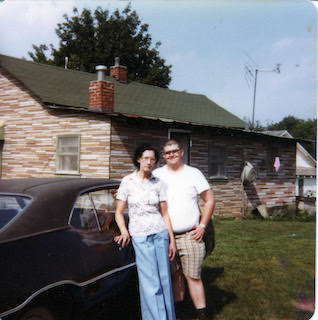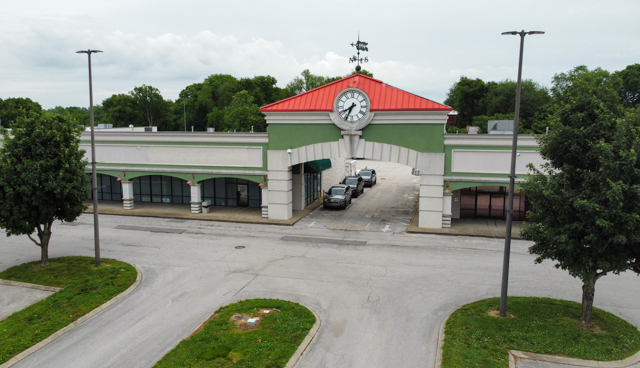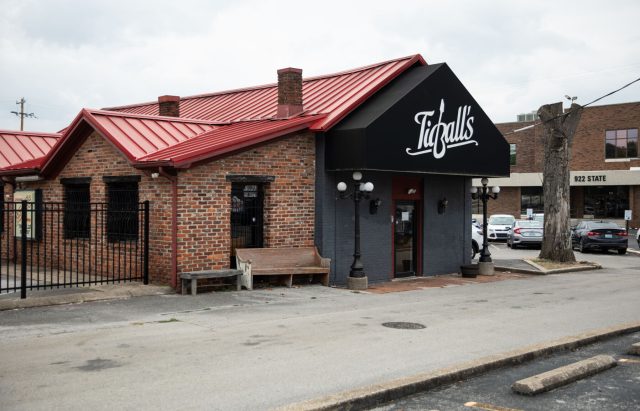Mammoth Cave ‘shames the fine things’
Published 1:02 pm Sunday, April 3, 2016

- On Echo River. Photo by Ben Hains. (Courtesy of Wm. Gross Magee)
For centuries, the area we now know as Mammoth Cave National Park has arguably been the linchpin that has brought people here, whether it be indigenous people mining for crystals deep in the cave system more than 2,000 years ago, a 19th-century doctor who saw the cave as a possible holder of healing powers for tuberculosis sufferers or present-day tourists and biologists who study and admire the rare bats, cave shrimp and other organisms that comprise the complex, flourishing ecosystem both on the surface and in the subterranean caves that render the word “mammoth” an understatement.
This year, Mammoth Cave is observing its 75th anniversary in the National Park System and commemorating 200 years since tours began being offered.
The poet and philosopher Ralph Waldo Emerson’s 1857 essay “Illusions” begins with a recollection of a tour of Mammoth Cave he made years earlier with a group of people who admired the Star Chamber, a portion of the cave in which cave crystals and soot from years of lanterns combine to produce the effect of a starlit sky on the ceiling.
Emerson noted that the chamber was “the best thing the cave had to offer.”
“The mysteries and scenery of the cave had the same dignity that belongs to all natural objects, and which shames the fine things to which we foppishly compare them,” Emerson wrote.
Johnny Merideth, a tour guide at Mammoth Cave for the past 20 years, said the allure that brought the first waves of curious tourists two centuries ago persists today.
“I think one thing is at its core, and that is caves are inherently interesting, mysterious places, and there are people all over the world who flock to this spot to explore and study, and people come to tour and visit these mysterious places to learn where do they go and what’s in there,” Merideth said.
Last fiscal year, about 478,000 people visited Mammoth Cave or took part in some ranger-led activity there, part of a record-breaking 307.2 million visits recorded at all NPS sites in 2015.
The earliest evidence of visitors to Mammoth Cave’s 52,830 acres dates back between 2,000 and 4,000 years ago, the age attributed to sets of human remains and artifacts such as torches and drawings that have been discovered there over the years.
The cave’s history as a tourist attraction has its roots in the early 19th century, when miners extracted saltpeter from the cave system to help make gunpowder during the War of 1812, Merideth said.
Mammoth Cave officially recognizes 1816 as the year guided tours began being offered, and Merideth said he recently came across a contemporaneous newspaper account in which the author remarked upon how people working in the area seemed to be oblivious to the natural beauty of the caves.
“There wasn’t the variety of tours that you have today, but the tours were overall much longer in that time,” Merideth said.
Never mind automobiles – rail travel was decades in the future in those early days, and southcentral Kentucky held much more wilderness, meaning that the earliest visitors to tour the caves were affluent people with the means and time to make the journey.
The presence of saltpeter made the land more valuable and raised its profile beyond the region, leading some enterprising landowners to trade on that reputation by charging visitors to tour the caves.
Franklin Gorin, a Glasgow attorney, bought the property for $5,000 in 1838. He sold the property the following year to Louisville doctor John Croghan, in whose family the caves remained for several decades.
Stephen Bishop, a slave that Croghan acquired in the $10,000 sale, spent the next several years exploring the cave system and mapping it, and is recognized as the first human to travel through large portions of the cave system.
“From about 1838 until about the mid-1860s, the majority of guides were slaves that would take people through,” Merideth said.
Croghan’s research into the well-preserved artifacts left over from previous centuries inspired him to build a sanitarium to house patients with tuberculosis – Croghan’s specialty as a doctor and a disease that had no cure at the time.
“Tours would pass a bizarre scene,” a history of Mammoth Cave on the NPS website states. “Pale, spectral figures in dressing-gowns moved weakly along the passageway, slipping in and out of shadowed huts, the silence of the cave broken by hollow coughing and muttered conversations.”
Croghan’s belief that the air within the cave could improve patients’ health was not borne out, however, and Croghan himself died from tuberculosis in 1849.
The cave, however, remained in his family until the 1920s, and in the intervening years rail service would cause an exponential jump in the number of annual visitors, sparking further geological study of the area and sowing a lodging industry to accommodate the thousands of sightseers.
The boom times fostered an environment known among park historians as the “Cave Wars,” in which owners of nearby cave properties resorted to aggressive, and at times unscrupulous, sales pitches to lure visitors to caves on their land rather than the Mammoth Cave property owned by Croghan’s estate.
“Cave City and the surrounding area kind of grew up and thrived for several hundred years on the tourism impact of Mammoth Cave, especially during the Cave Wars,” said Sharon Tabor, executive director of the Cave City Convention Center and Tourism Commission.
In 1925, Floyd Collins, whose family owned Crystal Cave, was exploring Sand Cave as a potential spot for tourists when a heavy rock dislodged and landed on his ankle, trapping him in the cave. Rescue efforts drew widespread attention and were thoroughly reported in the media of the time, but were ultimately unsuccessful, and Collins died after 18 days of entrapment.
It was in the early 20th century when support for making Mammoth Cave a national park gained traction locally.
“We were certainly one of the oldest tourist attractions, and the cave itself is incomparable for its size and history,” Merideth said. “There was a concerted effort on the part of a large number of citizens, organizations, businesses and the railroads that were very involved in wanting to make this a national park.”
The Mammoth Cave National Park Association was formed in Bowling Green in 1926, dedicated to acquiring the land that would be needed for Mammoth Cave to gain entry into the national park system.
Federal legislation passed that same year providing for the creation of Mammoth Cave National Park.
Using private donations at first and then receiving state funds, the association bought several acres of land for the park. Some properties were seized through eminent domain, and state legislation passed in 1928 allowed for land to be acquired through condemnation proceedings, resulting in the displacement of an estimated 500 families.
The NPS took control of land acquisition in the 1930s and by 1941, the minimum amount of land had been acquired to allow for the establishment of Mammoth Cave National Park.
Today, the park serves as an invaluable teaching tool that gives Kentuckians insight into their history and their environment. The Green River, which courses through the park, is an attraction in its own right for kayakers.
Travelers on Interstate 65 have a choice to make when the get off at Exit 53 in Cave City. On an average day, 1,500 drivers turn in the direction of Mammoth Cave, while 38 go the other direction into Cave City, according to Tabor.
“That many vehicles is a tremendous impact on lodging, dining and other expenditures for tourists in the area,” Tabor said. “Not many communities have the ability to have a 53,000-acre park in our backyard.”
According to the NPS, Mammoth Cave visitors spent an estimated $43.6 million in the region in 2014, with those expenditures supporting a total of 685 jobs, $21.3 million in labor income and $59.8 million in economic output.
Slightly more than half of that spending focused on restaurants and hotels, with transportation, gas, retail and recreation industries each responsible for about 10 percent of spending. The remaining visitor dollars were spent on groceries and camping.
Tabor and leaders in other communities are looking to incorporate the park into a far-reaching plan to encourage more exploration by tourists and healthier behavior among locals.
The Cave Country Trails project seeks to set up a network of connector trails among Barren, Edmonson, Hart and Warren counties.
Plans have evolved over the past year, and Cave Country Trails is receiving assistance from the National Park Service in developing the project and gathering public input.
When Mammoth Cave was envisioned as a national park, Tabor said one of the early hopes was that having that park would enhance the area’s outdoor tourism possibilities.
“With the Cave Country Trails initiative, we’re connecting 11 communities surrounding the park and revisiting the original dream,” Tabor said. “We have an opportunity to create something that will help more people in the area by creating hiking trails, biking trails and paths that bring the park in closer to town … and provide an opportunity for the community to get out.
“One of our initiatives is to provide user paths for multiple users, hikers and bikers out in the community.”
Help from the state in promoting adventure tourism and designating Munfordville as a Trail Town are seen as crucial steps in the Cave Country Trails initiative. An application to the state tourism cabinet to confer Trail Town status to Munfordville, which allows for more state assistance in publicizing the city’s trails and outdoor tourism avenues, has been submitted.
Mammoth Cave National Park has proved to be an economic juggernaut for the area, and the main reason for that may be the same as what attracted Emerson and others here generations ago.
“We don’t really write diaries or things like that now, but people are sharing their pictures on Twitter and Facebook, telling about their experiences on various travel sites,” Merideth said. “They’re still writing about their experience in Mammoth Cave, and while we’re detached from the days of a horse and stagecoach and a lantern lit with burning animal fat, I think a lot of the underlying experiences are the same and our reasons for them are the same.”
— Follow courts reporter Justin Story on Twitter at twitter.com/jstorydailynews or visit bgdailynews.com.






